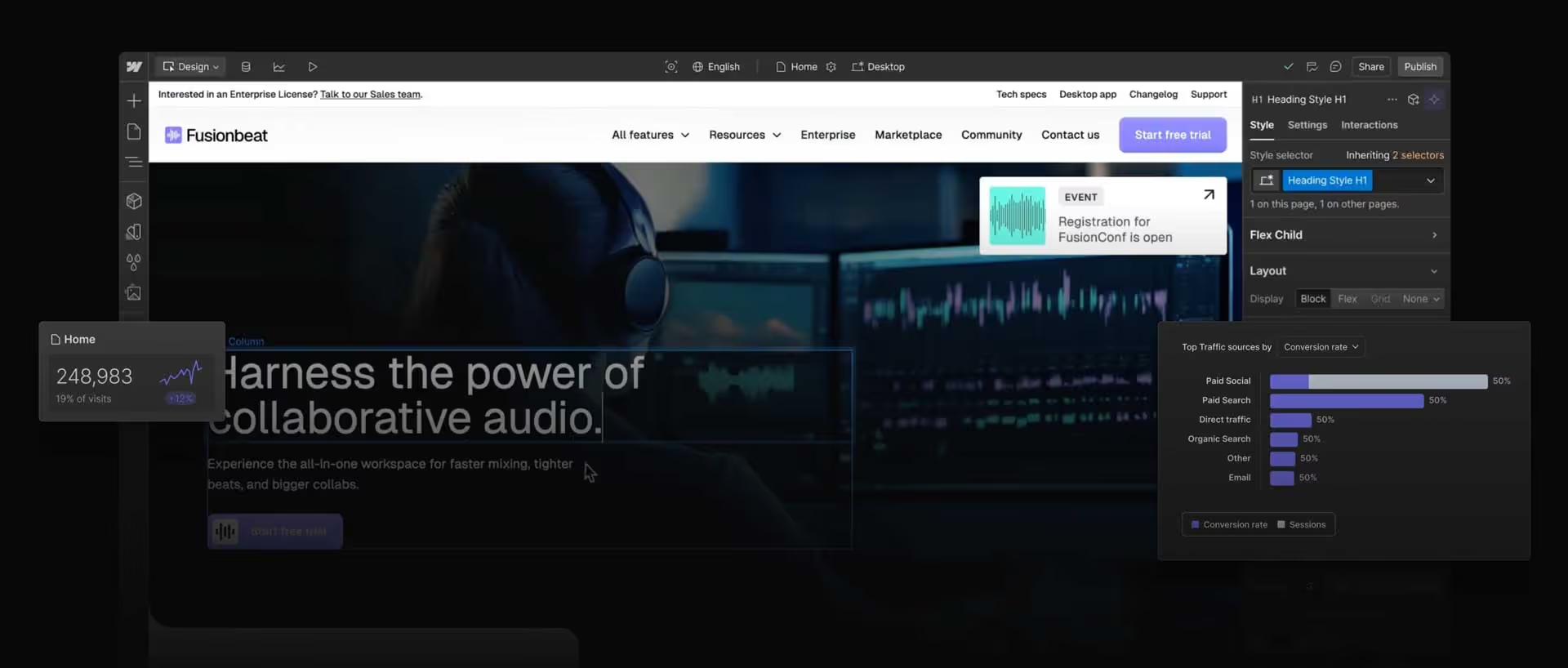Webflow vs Cursor: Website Builder Showdown

Webflow and Cursor.com represent two distinct approaches to modern website creation. Webflow is a design-driven, no-code platform built for marketers, designers, and teams who need full control over content, SEO, and scalability. Cursor.com, meanwhile, is an AI-powered development environment for engineers who want to accelerate coding, debugging, and collaboration. If your goal is to build marketing-ready, SEO-optimized sites fast, Webflow is the clear choice. If you’re a developer seeking an AI coding copilot for complex apps, Cursor.com leads the way. Together, they mark the rise of AI-enhanced web development for marketers in 2025.
In today’s fast-moving digital world, having a website that performs, converts, and scales is critical for businesses of all sizes. Whether you’re a marketing director at a growing startup or a founder looking to simplify your team’s workflow, the tools you use to build your online presence matter.
Two platforms making waves in this space are Webflow vs Cursor. While both offer modern solutions for building and managing websites, their approach, audience, and capabilities are quite different.
In this in-depth comparison, we’ll break down Webflow vs Cursor.com across key categories including user interface, SEO, pricing, templates, AI capabilities, and more. Plus, we’ll introduce one rising concept: AI-enhanced web development for marketers, a long-tail keyword that captures the essence of where these platforms are headed.
Overview of Webflow vs Cursor
Webflow
Webflow is a no-code/low-code website builder with powerful visual design tools, robust CMS capabilities, and native hosting. It allows designers to build fully responsive websites without writing traditional code, yet it generates production-ready HTML, CSS, and JavaScript in the background.
Ideal for: Designers, developers, marketing teams, agencies, and startups that want full control over branding, performance, and flexibility.

Cursor.com
Cursor.com is a collaborative AI-powered development environment, think of it as GitHub Copilot meets Notion and VSCode. It’s built for software developers who want to accelerate coding, debugging, and collaboration using generative AI.
Ideal for: Developers, technical teams, and AI-savvy engineers looking to supercharge their workflow inside a coding-first environment.

Webflow vs Cursor - User Interface and Ease of Use
Webflow UI
Webflow’s interface resembles design tools like Figma or Adobe XD but with a layout engine that mirrors how browsers render pages. The learning curve is steeper than drag-and-drop builders like Wix or Squarespace, but once mastered, it offers unmatched design flexibility.
Pros:
- Visual and intuitive for designers
- Fully responsive design control
- Built-in CMS and eCommerce
Cons:
- Learning curve for non-designers
Cursor.com UI
Cursor’s interface is more code-centric. Built on top of VSCode, it adds a sidebar chat powered by AI (similar to Copilot Chat) and integrates Git seamlessly.
Pros:
- Familiar for developers
- Lightning-fast code generation
- Great for debugging and documentation
Cons:
- Not suitable for non-technical users
- No visual site builder
Webflow vs Cursor - SEO Capabilities
Webflow SEO
Webflow gives full control over SEO-friendly markup, meta tags, open graph settings, 301 redirects, alt attributes, and more, all from the UI.
- Custom meta titles and descriptions
- Clean code output
- Fast hosting (on AWS & Fastly CDN)
- Automatic SSL, sitemap, and accessibility features
Standout Feature: Webflow’s ability to generate fast-loading, semantic HTML gives it a serious SEO edge.

Cursor.com SEO
Since Cursor is not a website builder per se, but a code assistant, SEO capabilities depend entirely on the implementation by the developer. You can write SEO-optimized code using Cursor’s AI suggestions, but it won’t handle meta tags, sitemaps, or image optimization for you.
Best For: Developers who know exactly what they want to implement manually.
Webflow vs Cursor - Pricing Comparison
Webflow Pricing (2025)
Webflow separates its pricing into Site Plans and Workspace Plans:
Site Plans (for hosted websites):
- Starter: Free (Webflow.io domain)
- Basic: $18/mo (custom domain, 250k monthly visits)
- CMS: $29/mo (for content-driven sites)
- Business: $49/mo (high-traffic, advanced features)
Workspace Plans (for teams):
- Starter: Free (1 seat)
- Core: $19/month/user (3 users)
- Growth: $49/month/user (10+ users)
- Enterprise: Custom
Cursor.com Pricing (2025)
Cursor currently offers a freemium model, with paid plans focused on AI feature usage and collaboration:
- Free: Limited AI queries, 1 project
- Pro: $20/month – Unlimited AI, cloud access
- Team: $40/user/month – Collaboration, org features
- Enterprise: Custom – Full integration, security features
Verdict: Webflow is more structured for content and design-based projects, while Cursor scales better for dev teams managing complex apps. For in-depth Webflow pricing explanation click here.
Webflow vs Cursor - Templates and Customization
Webflow Templates
Webflow has a rich marketplace with over 2,000 templates for businesses, portfolios, SaaS, and eCommerce. Templates are fully customizable and built with best practices in mind.
- Paid templates: $24–$149
- Free templates available
- Figma-to-Webflow workflows supported
Cursor.com Templates
Cursor doesn’t offer visual website templates. However, developers can use AI to generate code snippets and even full React components based on prompts.
- Reusable code snippets
- Shared notebooks
- Prompt-based design patterns
Webflow vs Cursor - AI Capabilities
Webflow
Webflow recently introduced AI features including:
- AI page structure generation
- Copywriting suggestions
- Auto-generating meta tags
- Style naming (Client-First conventions)
Still early, but it hints at a future where AI-enhanced web development for marketers becomes the new standard.

Cursor.com
Cursor is built around AI from the ground up. Its assistant can:
- Generate code from natural language
- Refactor existing code
- Answer documentation questions
- Create tests and scripts
- Debug with context
Its AI memory and chat context are best-in-class, making it more powerful for raw development tasks than Webflow.

Webflow vs Cursor - Learning Curve and Community Resources
Webflow Resources
Webflow excels at education:
- Webflow University (award-winning tutorials)
- Community forums
- YouTube tutorials
- Events and meetups
- Certification programs
If you’re coming from design or marketing, the ramp-up is manageable.
Cursor.com Resources
Cursor has GitHub-style documentation, Discord-based community support, and limited official onboarding. It assumes technical fluency.
Webflow vs Cursor - Integrations and Extensibility
Webflow
- Native integrations: HubSpot, Mailchimp, Google Analytics, Zapier
- Custom code (HTML, JS)
- Third-party embeds
- CMS API and Webflow Apps marketplace
Cursor.com
- Git, GitHub, VSCode extensions
- Terminal access
- OpenAI API integration
- Plugin system (early stage)
Final Verdict: Which One Is Right for You?
Choose Webflow if you:
- Need a fully custom, responsive website without writing code
- Want full SEO control and high design flexibility
- Are a marketer, designer, or startup team
- Care about templates, CMS, and visual branding
Choose Cursor.com if you:
- Are a developer building web apps, not just static sites
- Want deep AI integration to enhance coding speed
- Work with Git workflows and prefer code-first environments
- Need collaborative debugging and scripting tools
Conclusion
Both Webflow and Cursor.com are forward-thinking platforms, but they serve very different audiences. If you’re looking for a visual website builder that balances design, performance, and marketing needs, Webflow is hard to beat. On the other hand, if you’re building complex software and want AI to be your coding partner, Cursor.com is a game-changer.
Whatever path you choose, the future is clearly leaning toward faster, smarter, and more collaborative web development, and both tools are part of that story.

.svg)
.svg)


.svg)




